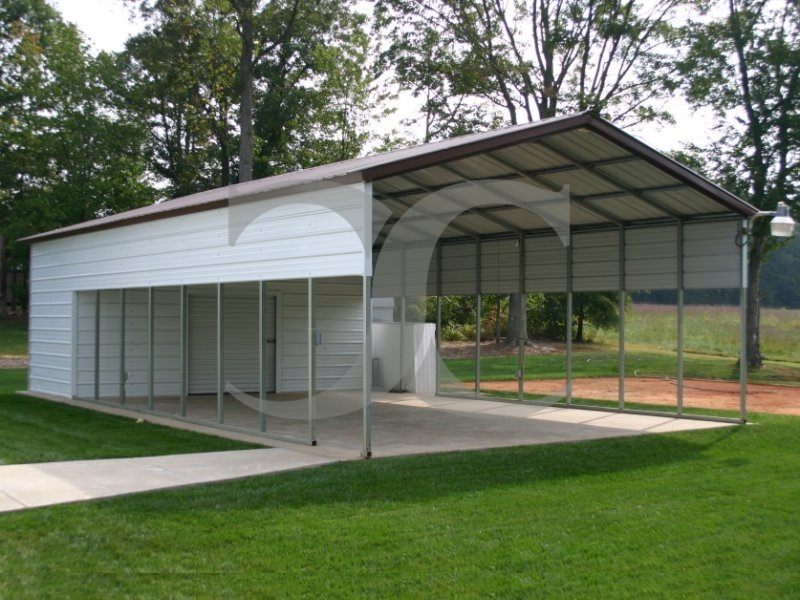What Drives Demand for Single and 2 Vehicle Carports
- Jack Ranson
- Jul 30
- 3 min read

The carport industry has witnessed remarkable growth in recent years, with homeowners increasingly recognizing the value of protected vehicle storage. Market trends reveal distinct preferences between single metal carport installations and larger dual-capacity structures. Understanding these driving factors helps explain why property owners are investing in these practical solutions at unprecedented rates.
Economic Factors Fuel Market Growth
Financial considerations remain the primary catalyst behind carport popularity. Traditional garage construction costs have risen dramatically due to material shortages and labor expenses. Homeowners find that a single metal carport provides substantial vehicle protection at a fraction of the cost. Construction permits for carports typically require less paperwork and lower fees compared to enclosed structures.
The economic appeal extends beyond initial investment. Property insurance companies often recognize carports as permanent improvements, potentially reducing premiums for vehicle coverage. Maintenance costs remain minimal since these open-sided structures require less upkeep than enclosed garages. Cardinal Carports reports that customers frequently cite budget constraints as their primary motivation for choosing carports over traditional garage construction.
Installation timelines also impact financial decisions. Most carport projects complete within days rather than weeks. This efficiency reduces labor costs and minimizes disruption to daily routines. Homeowners appreciate avoiding the extended construction periods associated with major building projects.
Changing Household Needs Drive Size Selection
Family dynamics significantly influence whether customers choose single or dual-capacity options. Young professionals often start with a single metal carport to protect their primary vehicle. As households grow and acquire additional cars, many opt for expansion or replacement with a 2-vehicle carport to accommodate changing needs.
Modern vehicle sizes also affect purchasing decisions. SUVs and pickup trucks have become increasingly popular, requiring larger coverage areas. A standard single-capacity structure might feel cramped for oversized vehicles, leading customers toward wider configurations. Conversely, urban dwellers with compact cars find single units perfectly adequate for their requirements.
Seasonal vehicle storage presents another consideration:
• Motorcycles and recreational vehicles need protection during winter months
• Boats and trailers require covered storage between seasons • Classic cars benefit from shelter while maintaining easy access
• Work vehicles need protection from weather-related damage
Weather Protection Concerns Motivate Investment
Climate-related vehicle damage drives significant demand for covered parking solutions. Hail storms cause billions in automotive damage annually, particularly affecting regions with severe weather patterns. A 2-vehicle carport can protect multiple family vehicles simultaneously during harsh conditions.
Sun exposure creates long-term damage that many vehicle owners underestimate. Ultraviolet rays fade paint, crack dashboard materials, and deteriorate interior surfaces. Metal roofing effectively blocks harmful radiation while maintaining proper ventilation around parked vehicles.
Winter conditions present unique challenges that covered parking addresses. Ice accumulation on windshields delays morning routines and creates safety hazards. Snow removal becomes unnecessary when vehicles remain protected overnight. Cardinal Carports emphasizes these weather-related benefits when consulting with customers in climate-sensitive regions.
Space Utilization and Property Value Enhancement
Available land area often determines carport size selection. Homeowners with limited space might choose a single metal carport to maximize their property's functionality. Those with larger lots frequently opt for multi-vehicle configurations that accommodate guests and provide additional storage space.
Carports serve multiple purposes beyond vehicle protection. They create covered outdoor workspaces for hobbies and maintenance projects. Many homeowners use them for temporary storage during moving or renovation projects. The versatility adds functional square footage without the expense of permanent building construction.
Technological Advances Support Market Growth
Modern manufacturing techniques have improved carport quality while reducing costs. Galvanized steel frames resist corrosion better than previous generations of metal structures. Improved fastening systems create stronger connections that withstand severe weather conditions.
Customization options now rival traditional construction projects. Customers can select specific colors, roof pitches, and dimensional configurations. Cardinal Carports offers extensive customization possibilities that meet individual property requirements and architectural preferences.
Future Market Trends and Considerations
Industry analysts predict continued growth in both single and multi-vehicle carport segments. Rising construction costs make affordable alternatives increasingly attractive. Environmental consciousness also supports structures that require fewer materials than enclosed buildings.
The trend toward remote work has changed vehicle usage patterns. Homeowners spend more time at their properties and pay greater attention to vehicle maintenance and protection. A 2-vehicle carport provides the flexibility needed for changing transportation requirements. Want to learn more?
Check out our blog: How to Choose Between Carports Tulsa and Single Metal Carport?
Cardinal Carports anticipates that technological improvements will continue driving market expansion. Smart integration possibilities and enhanced materials will attract tech-savvy consumers seeking modern solutions for traditional challenges. The combination of practicality, affordability, and adaptability ensures sustained demand for both single and dual-capacity carport installations.









Comments